Island Bluefish
From Block Island to the Azores, the mysteries of bluefish make them a fisherman’s favorite.
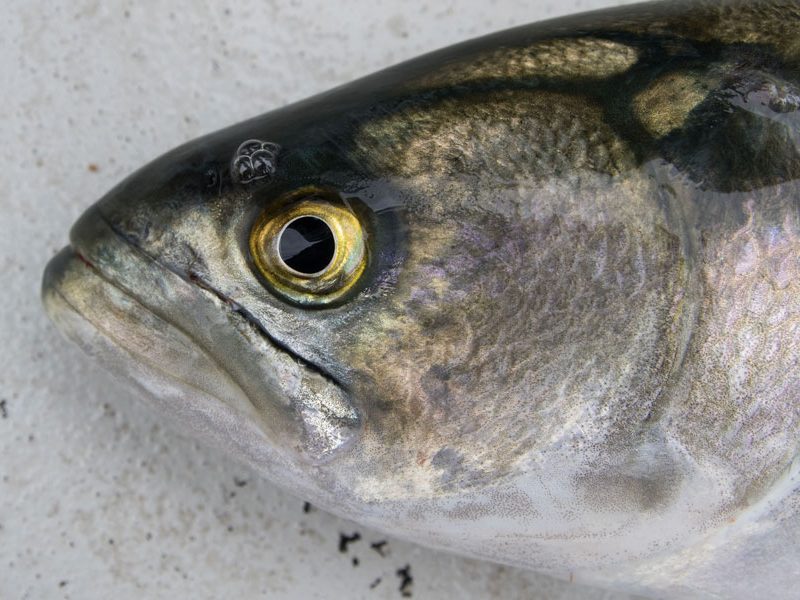
To me, bluefish are one of those fish that tend to be way bigger in my mind than they should be. Some of this has to do with timing. I came of age in the 80s and those were bluefish years. In 1984, I was 14, the year when giant blues seemingly gathered everywhere in southern New England. Blues are great when you’re young. Shirtless summers. The ocean greased with fish slicks. Terns in the air. And the fight! What young kid doesn’t like trying to match his or her mettle against one of these fish? Despite the blues’ reputation as being fairly simple to hook, finding them is not nearly as easy as it once was.
August in Coastal Rhode Island
A few years ago (August 21, 2017, to be exact), there was a ton of media talk about the Great American Eclipse. People were all abuzz about it. Those protective glasses—the ones where you can look directly into the sun—had sold out. All the hype had made me want to get out on the boat, where the bellow of mankind has a slightly dimmer tone. That week, there had been a decent show of blues around. In fact, for the past five years, the middle of August had been reliable for good-sized coastal blues. The runs, however, were short, from a couple of weeks to what felt like a couple of days. So, I loaded up my son and stepson, a few rods, and my snorkel gear. I mentioned the eclipse and that the moon was going to blanket out the sun. “Cool,” they said.
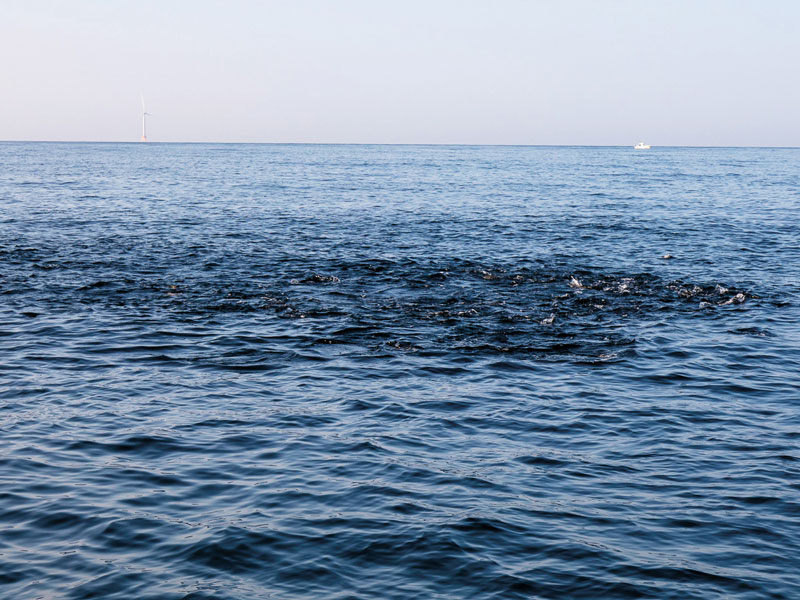
We motored out, and the blues were there, terns were dipping, and we saw a few boils on the surface. We trolled small Yo-Zuri swimmers with the belly hooks removed. It didn’t take long. “Watch the rod, watch the rod,” I said. Then, bam!
With blues, it’s all about the hit. From umbrella rigs to Polaris Poppers, the first five seconds are it. All the while, I kept an eye on the sun.
In Rhode Island, the eclipse time was around 4:15. As that time drew closer, I started to see a change in the hue and tone of the sky, as if evening was coming hours sooner. The hack ecologist in me started to roll out the questions: Did the blues feel this? Was there something—an energy or a feel—they were picking up that I had not a clue about? I eyeballed my snorkel gear. “I gotta go in. I need to get wet,” I told them.
I drove the boat into shallow water, where it was calm, with no chop or swell. I knew the boat would ride fine at anchor. I got into 15 feet and slid it over the bow. “Don’t look directly into the sun,” I told the 13-year-old. “It can fry your eyes. Watch your brother, too.” I got into my wetsuit and fins as we edged closer to eclipse time. The sky began to darken—not by a crazy amount, but noticeably. It had an eerie, lurid cast. I always get revved up right before I jump over the rail and into the blue void, but this time my heart raced as if I were about to witness a historic moment.
I hit the water and the bubbles cleared, then I looked back at the boys, who were peering over the port rail. You know the dive is going to be good when you see fish the second your eyes adjust to being underwater. I took a breath and dove straight for the bottom. On my way down, I heard the sounds of fish tails, which are odd and mysterious. I don’t understand the physics of this noise, but I’m pretty sure it has to do with pressure waves coming off a fish’s tail and how sound travels underwater. For instance, a big striper broomtail sweeping through the water feels like a sonic boom inside my body. It can be freaky, especially if I’m not expecting it.
On this dive, what I heard were the sounds of hundreds of tails. Pop, pop, pop, pop – all around me. When I hit bottom and looked up toward the surface, the entire scene was covered in fish. In the seven years that I’ve been a free diver, I have never seen a bluefish school like that. The fish blew by and filled my field of vision. A bluefish swimming is not a calming sight. Not quite as jacked up as an albacore but not far off. These were choppers too—not a common sight for me underwater.
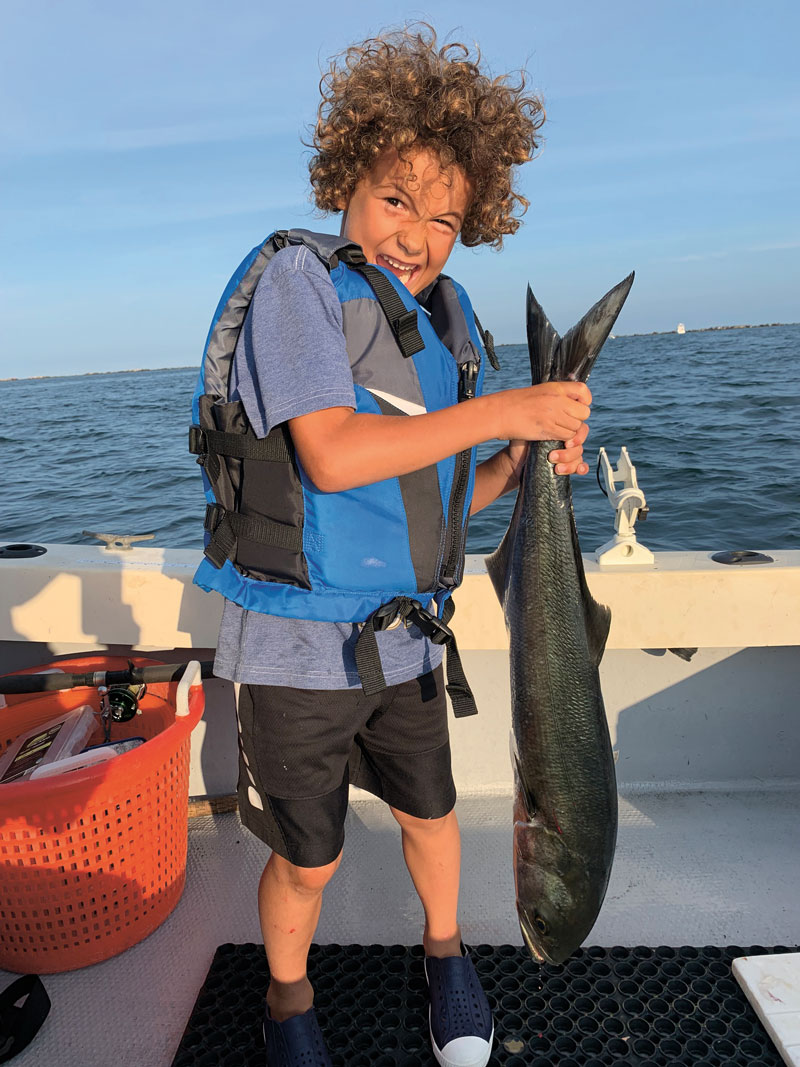
I took it all in. With the blues were stripers. Normally, when I see the two mixed together, the stripers far outnumber the blues. Not this time. On bottom were schools of scup and a few blackfish – layers of fish. And all of them, including the scup and blackfish, swam actively, hunting. Was that the eclipse? Was there some cue they picked up on that I was blind to?
I swam back up to the boat and we headed in. I had missed the eclipse and the boys had not been blinded.
I think the mid-August pattern has been fueled by bay anchovies, more so close to shore, from 35 feet to the surf break. That’s where these blues have been because I see the bait when I dive, big globs of them. In July, the anchovies are tiny, still in larval stages, but in August, they start to grow. The blues and bass vacuum-feed by opening their mouths and swimming through the swarms. Once the bonito start to show, at some time in late August, the blues are gone. The fish that do stay and mix with the bonito, school bass, and albacore are small. The run is over before you even know it.
The Block
Bluefish around the Island can be giant. The fish show in June, but if you talk to the guys who catch a lot of them, the big fish don’t come until July and August. The July fish are tied to the sand-eel runs, and the August and September fish are tied to baby butterfish. Most of the best bluefishing is outside 45 feet, though the fish go shallow as well.
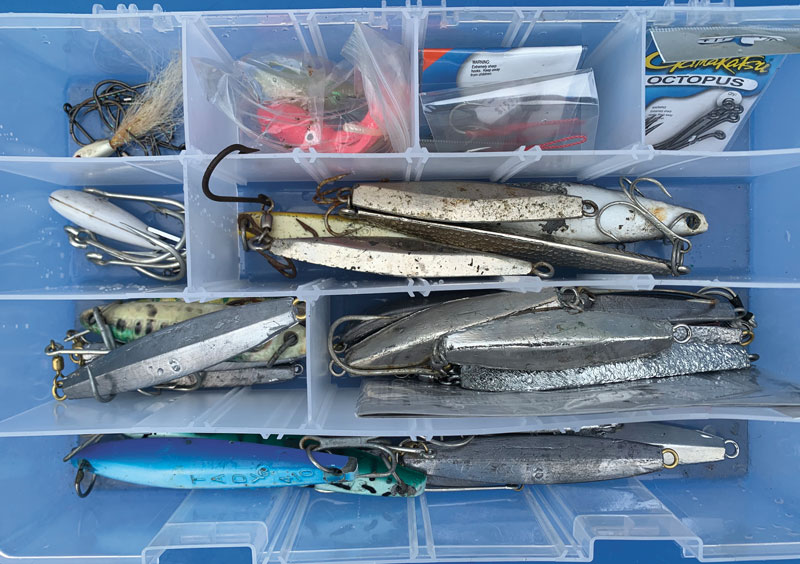
I think the best way to get these fish is with jigs. If you are marking bait in 60 feet in August, drop down a jig. I carry a whole box of them that range in size from 3 to 10 ounces and they are the same ones I use for codfish, sea bass, and stripers. Drop down and crank, then stop halfway and let the jig freefall back. I like jigs, and they deserve to be in anyone’s anthology.
For blues, keep the jig in motion – even more so if summer dogfish are around. For whatever reason, big blues tend to hang around dogfish schools, or maybe it’s the other way around. I’m not sure, but if you find one, you tend to find the other.
As for Block Island bluefish abundance, they are not a given. Few people actually go out looking for them – it’s more of a bycatch thing. Blues could show anywhere: the North Rip, the West Grounds, the Southwest Corner, the Backside, East Grounds, Windmills. Commercial fishermen pull hairs over not only finding them but staying on them once they’re found. A single tide and the fish can be gone. The past two seasons have been on the slow side at the Block. I heard of small pops of fish here and there.
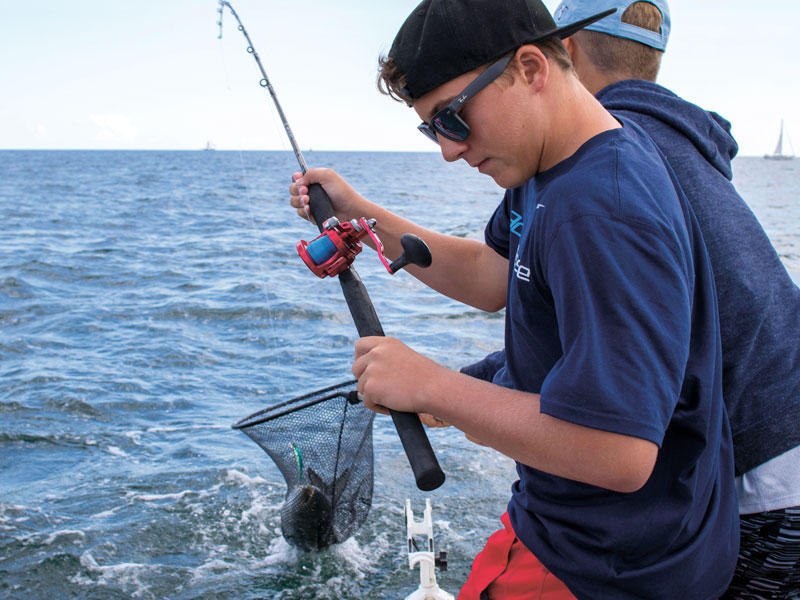
The best run of recent bluefishing action was in 2011, though 2015 and 2016 were decent too. I have no idea where we are in the blues cycle—rock bottom? Slightly off bottom? Midway? Each year seems different, and so much depends on who you talk to and where. Those on the Cape have a different take than guys off Jersey, but I don’t think it has been very good anywhere. Yet, the funny thing as I write this is that friends of mine who fish bass in Narragansett Bay in May and June are seeing big signs of blues. Perhaps they are promising signs.
The Azores & More Questions
Two summers ago, I went to the Azores with my family. It wasn’t really a fishing trip because my wife’s family and relatives are all from there. I packed two rods, a mask, and snorkel. I hardly fished, but I observed as much as I could about what the local fleet and shore fishermen were up to.
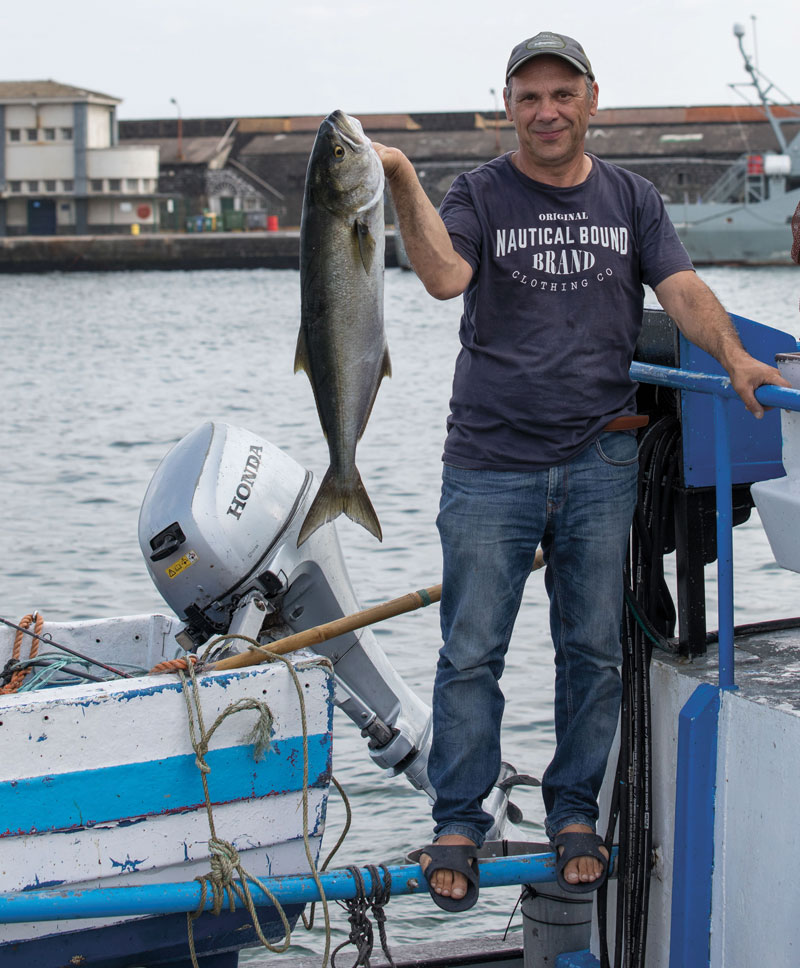
The Azores are an island chain out in the Atlantic Ocean, 930 miles west of mainland Portugal, and just over 2000 miles from Boston. The islands are definitely oceanic. The whole vibe of them is oceanic. You can picture swordfish and bigeye and bluefins a stone’s throw from the rocks.
We were staying in Sao Miguel, the main island. There is a harbor there with small freighters and fishing boats. It was also the place where plenty of locals tried to catch dinner. I saw people with cane poles, handlines, rods and reels. You can learn a lot about a culture by walking the docks. On one trip, I saw a guy with a deep bend in his rod. I heard his drag slipping. He was grinning. He was standing on a docked tuna boat. When he landed it, and hoisted it up, I saw it was a blue. For whatever reason, this floored me. It was as if this guy had just landed his fish off Brenton Reef or West Chop. I knew blues lived in the Azores, knew they run the coast from Spain down the coast of Africa—but knowing something and seeing something are two different things. That Azorean blue got me thinking about how pelagic and nomadic these fish are. The blues have to get to the Azores, a long swim. Or the resident Azore blues, I’m sure, move from island to island, and even this has depths that are thousands of feet deep. What about the blues in the Canary Islands and Bermuda? That’s deep ocean—Cuban-Trench deep. My point is that blues don’t give a hoot about swimming way off the shelf break. I bet they are coded for it. I’m not saying blues are down at the bottom but they certainly don’t mind being in it.
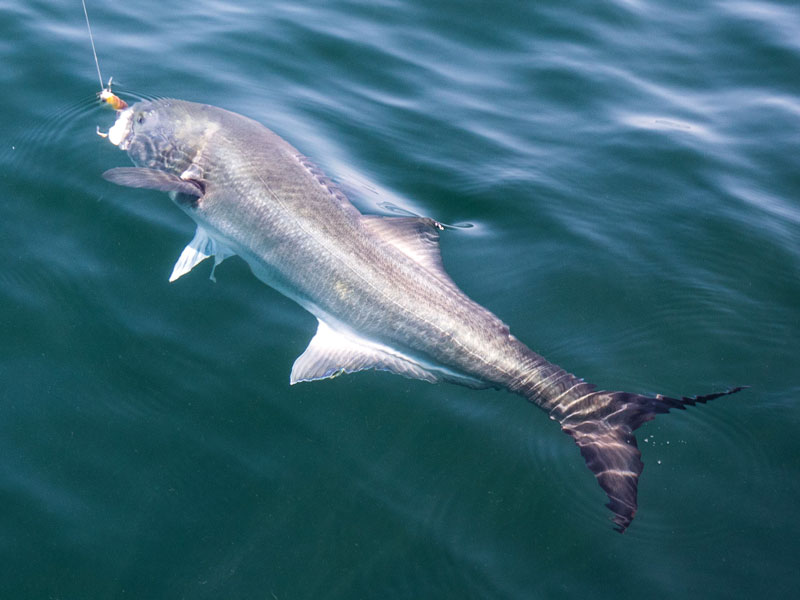
Back at home in Rhode Island, I thought about this. I’ve seen plenty of ocean blues—caught them off Hudson Canyon in the wintertime in 500 feet. Big beautiful fish with dorsal flanks more black than blue. Other guys have seen plenty offshore as well—the tilefish boats, the squid boats. They have all seen blues in 100 fathoms of water, on bottom.
Again, this is one reason that I like bluefish as a fish. They really are, to use teenager slang, badass. We see them in the surf and the deep rips of the Race; we see them in pogy schools in the harbors of Buzzards Bay; see them out in the Dump and the Butterfish Hole. Yes, they will chop your eels in half and ruin your tuna spreads, but on the right rod, a big blue is a joy to behold.
I looked up bluefish in the IGFA record books, and something surprised me. The biggest blues come from two locations: North Carolina and the Azores. These two regions, though 2,000 miles apart, share almost the same latitude, which is around 35 to 37 degrees. That may not mean much, but it is curious. I guess the big blues like that band of latitude.
This is pure speculation, but I wonder if, when we are having a down cycle, the Azores and the eastern Atlantic are having an up cycle. I wonder if we lose some fish out in the Atlantic. The experts say the populations are separate – there is no mixing. Fair enough, but didn’t we think that was the case for bluefin tuna for the longest time? Now we know they do mix.
And what about the tagged striper last year that decided to head out to Hudson Canyon? Crazy, right? Anyway, my point is we don’t know much about how these fish move and why. It’s why I love fish and fishing. We just don’t know, but either way, that’s one heck of a cast from Nantucket.
Related Content
14 on “Island Bluefish”
-
David Martins Brilliant article. Very well writen.
-
Joe Antonelli Great article, so glad Bluefish are not tasty. If they were they would be wiped out by now. Love catching and releasing these guys.
-
George C. Have you ever gone to Brooklyn New York? There is a harbor there that has charter boats that go out in the evenings around 6 p.m. and don’t come back until past midnight. Anywho I remember fishing Bluefish there in the mid 90s to early 2000s and they were monsters we’re talking 3+ feet long and heavy to the fight they gave when they got hooked is something I will never forget. Just wanted to share this comment you may want to add the Atlantic Ocean of the coast of New York as your next checkout spot….
-
Fishnski Wonder how that Azore local was going to cook that big blue..they are oily fishy strong at that size…my wife and I only eat the small snappers..that day..never freeze them!
-
Jeff Wynkoop Great article: I grew up on Bluefish on Long Beach Island ~ Beach Haven ~and love them. Best to cook them in an aluminum foil pouch with seasoning and just fresh lemon slices. Used to get them at the 28 Mile Wreck and just fill the barrel until we were tied of reeling. Those were the days! Tight Lines…
-
Mike O’Mara Fillet a fresh caught bluefish, then remove ALL the dark stuff. Cut in chunks and soak in milk overnight. Beer batter and deep fry, squeeze fresh lemon and maybe tartar sauce, then tell me you don’t like bluefish.
-
J Tatro I never imagined reading a guy’s tale of jumpig into a bunch of bluefish. Not that I’ve read much about fish, & never bluefish, since college days some generations ago. I always pictured them as very large piranhas, see them boil & having seen what they’d do to a big double-hooked eel 40 years back when my dad would get a slip in Sung Harbor & then take us out off Mohegan Bluffs during their run. Catching 3 of those 16-pounders was a huge workout. Great article, fun!
-
Jtatro Pardon the typos! Submit first, check later. Snug Harbor, for one. ; )
-
-
Paul From MA, Live in Houston, TX. I’ve caught bluefish in MA, TX and the Azores.
One September morning in Galveston they were stacked against the beach, about 2 lbers. I caught about 25 and left them biting as my buddy wanted to search for speckled trout. Only time I’ve run into them here.
When I visited the Azores (Sao Miguel), I was throwing a bucktail in Aqua de Pau and WHACK!! I was surprised to land a bluefish in the middle of the ocean.
The other fish I have similar feeling for is the Largemouth Bass. At one point I looked at them as generic. I’ve caught them in Northern VT in February and here in suburban Houston (Clear Lake area). I’m amazed their resilience, that incredible range and they are pretty strong. -
Rich H I used to catch monster bluefish while shark fishing 30 miles out of jones inlet on Long Island. I was really surprised when I pulled in 3 one nite fishing off marathon Florida keys. They certainly have some range.
-
Rick Of all the fish species I have caught nothing beats the excitement of snagging bunker and waiting for a gorilla blue to hit on the run
-
M s Younus Here in South Africa we get them year round .off the back line in Durban throughout the year this fish got banned from fishing them as a conversation aspects actual fact it’s the staple food source for the indian community in the coast line . hawever the blue fish as we refer to being shad or elf in Afrikaans was banned from fishing them this was racially implemented . when someone catches over bag limit or during baned season they heavily fined . government is corrupt in apheid time and now as well
-
Stephen J Jesus Bluefish are way more fun to catch than a striper but the striper gets all the ink. Don’t know why
-
Bruce S Because bluefish taste horrible?
-
Leave a Reply